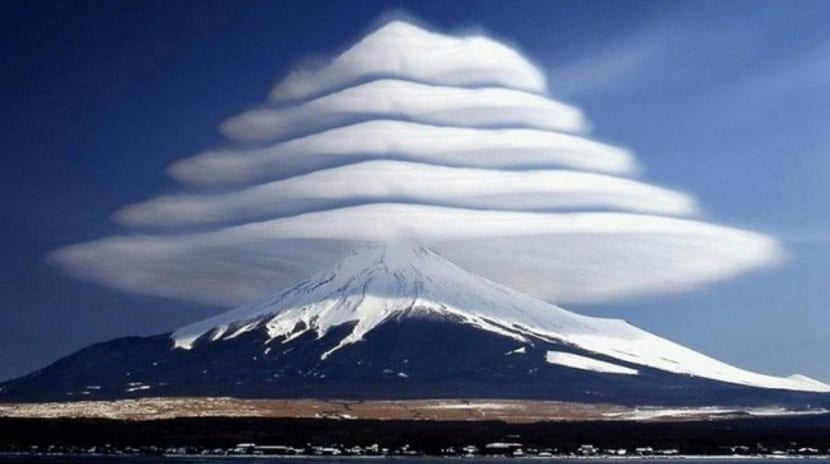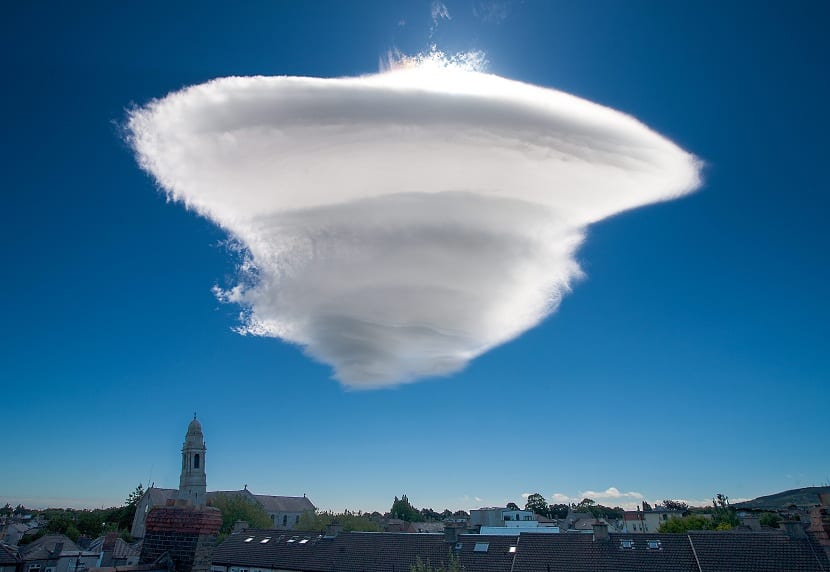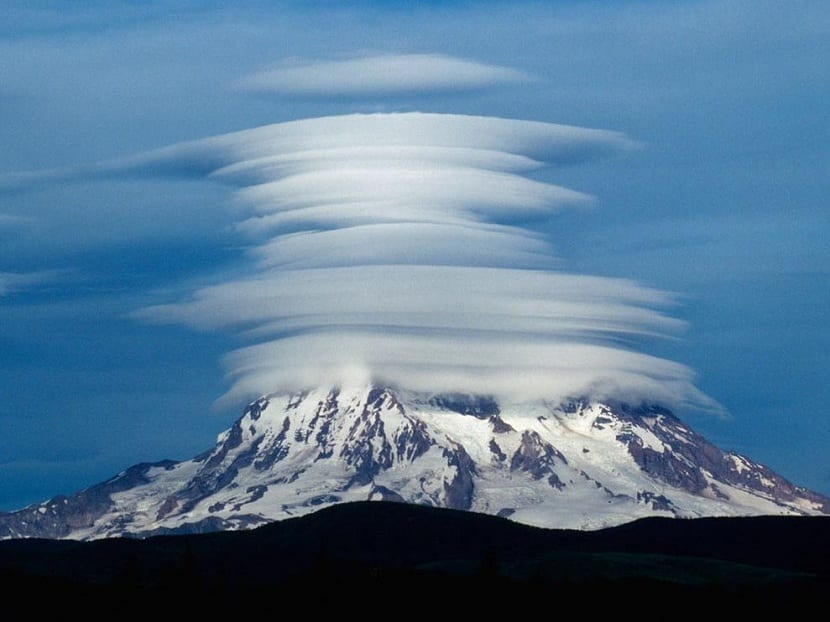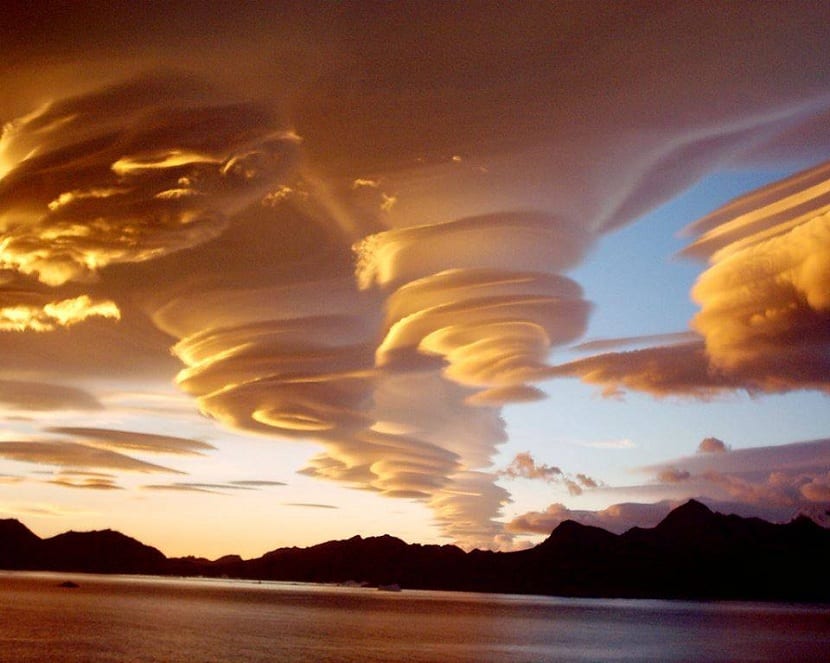
Many people have ever mistaken a cloud for a UFO. Everyone who has seen these types of clouds They have thought that nature is laughing at the existence of life outside of our planet. However, this is not so. These formations in the sky are due to the existence of lenticular clouds. They are a type of cloud that has the shape of a saucer or converging lens that usually appears in mountainous areas.
In this article we are going to tell you what these lenticular clouds are and how they are formed. If you are curious and want to unravel these mysteries, this is your post 🙂
What are lenticular clouds?

As we said, They are a type of clouds that have a saucer or UFO shape and that appears in mountain areas. Already the fact that it appears only in mountain places can give us clues of the training conditions that it needs to appear like this. They are clouds that form in the troposphere, that is, in the lowest of the layers of the atmosphere.
The characteristics of this cloud are those of altocumulus. Unlike normal Altocumulus, it is a stationary and lenticular type (called by scientists altocumulus lenticularis). It can also take the forms of stationary lenticular cirrocumulus or stationary lenticular stratocumulus. These formations depend on the environmental and atmospheric conditions such as the wind regime, the atmospheric pressure, humidity or temperatures there is at that time.
The most characteristic aspect of these clouds is that they give rise to impressive landscapes and have been confused many times with UFO sightings.
Training process

So that we can clear up all the unknowns about the exceptional rarity of these clouds, we are going to explain the origin of their formation. As we have said before, it needs various atmospheric and environmental conditions to occur. The first thing is a relatively strong upwind flow and encountering a reversal in the atmosphere. These conditions are more likely to occur in mountain areas, where the air, once it collides with the rock formations, is forced to ascend.
Mountains are mechanical obstacles to the flow of air in the atmosphere and thanks to them some events such as the Foëhn effect. When traveling through the air in an upward direction and with a thermal inversion, turbulences are generated that are classified as mechanical turbulence. The air finally reaches the top with much lower temperature than it was on or near the surface.
As it continues to move higher and higher through the atmosphere, the temperature continues to drop further and further due to thermal inversion. If the air that has risen along the mountain is humid, that is, it is loaded with drops of water, the humidity condenses as the temperature decreases at altitude, since it reaches the dew point. As the rising air condenses, we find the formation of a cloud mass that grows to the top of the mountain and that, upon meeting the thermal inversion, lenticular clouds will form.
Necessary conditions for their training

Surely you are thinking that there is always a thermal inversion and that, as we are ascending in altitude, it is colder. Therefore, lenticular clouds should always form. It is true that, in general, the upper layers of the atmosphere are colder than the lower ones. These lower ones are fed by the heat that is released from the ground when the solar radiation on the earth's surface.
But this need not always be the case. There are times when the ground is colder due to a decrease in the amount of sunlight that hits a surface or even the color of said surface (remember that darker colors absorb heat and whites reflect it. it is called albedo). In the case where the ground is colder, the ground itself can absorb all the heat from the surrounding air, making the lower layers of air are at a higher temperature than the upper ones. It is in this situation that we find the thermal inversion.
The areas that have thermal inversion are usually stable over time, so that the air, when trying to climb the mountainside, will be displacing the upper warm air that will go down again creating stationary areas that they trap condensed moisture and give the cloud a lenticular shape. This is the reason why these clouds look like UFOs and have been mistaken for them numerous times.
Why avoid flying near lenticular clouds?

It has always been said that flight pilots try to avoid flying in the areas near lenticular clouds at all costs. Let's see why this happens. As lenticular clouds form when the wind is strong and comes loaded with moisture, the ascent up the mountain and the condensation as you go up is quite fast. Having a high stationary layer of thermal inversion makes the wind circulate for a long time in an upward position.
Formations of these clouds can also be found when two opposing air masses collide and cause the hottest part to rise and cold air takes on the role of mechanical obstacle. The reason why pilots do not want to fly in these areas is because the characteristics of the wind associated with these clouds is very strong and in an upward direction and can cause serious destabilization in flight.
On the other hand, this type of wind is highly sought after in those flights that do not use the engine since the air currents are used to plan better and maintain the flight for longer. A curiosity is that the world record for gliding it has been achieved thanks to the air currents that give rise to lenticular clouds.
I hope this information helps you learn more about this type of cloud and its formation.
Ok, but the photo is photoshopped. The original is better.